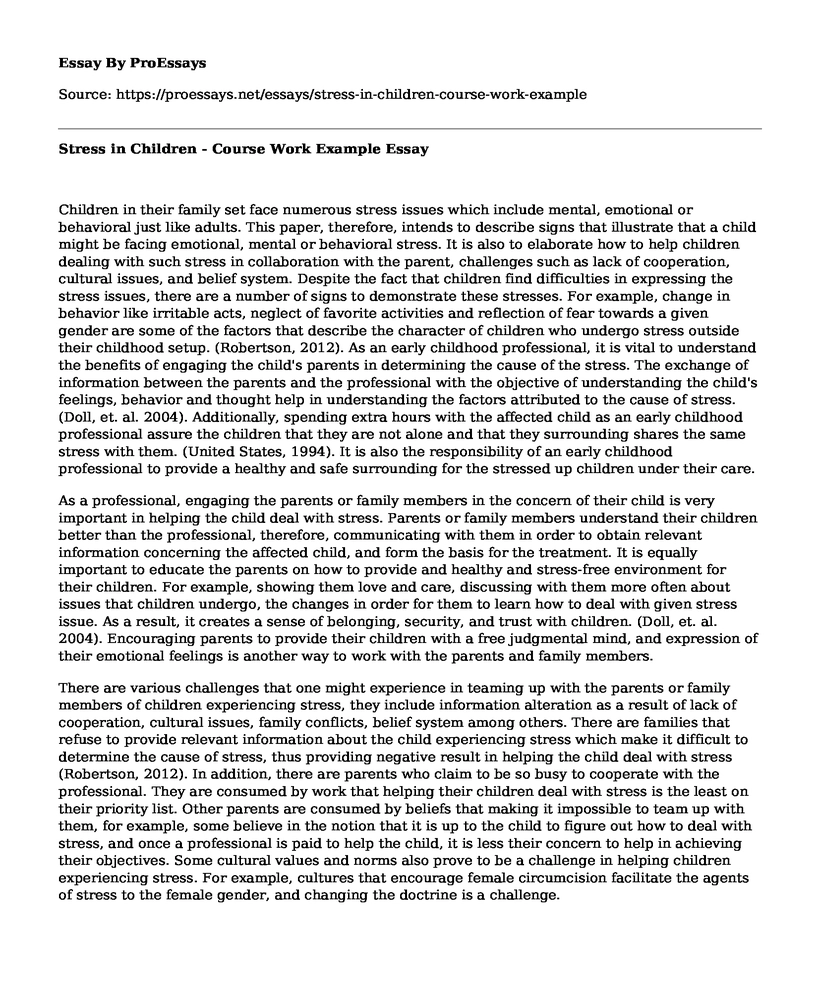Children in their family set face numerous stress issues which include mental, emotional or behavioral just like adults. This paper, therefore, intends to describe signs that illustrate that a child might be facing emotional, mental or behavioral stress. It is also to elaborate how to help children dealing with such stress in collaboration with the parent, challenges such as lack of cooperation, cultural issues, and belief system. Despite the fact that children find difficulties in expressing the stress issues, there are a number of signs to demonstrate these stresses. For example, change in behavior like irritable acts, neglect of favorite activities and reflection of fear towards a given gender are some of the factors that describe the character of children who undergo stress outside their childhood setup. (Robertson, 2012). As an early childhood professional, it is vital to understand the benefits of engaging the child's parents in determining the cause of the stress. The exchange of information between the parents and the professional with the objective of understanding the child's feelings, behavior and thought help in understanding the factors attributed to the cause of stress. (Doll, et. al. 2004). Additionally, spending extra hours with the affected child as an early childhood professional assure the children that they are not alone and that they surrounding shares the same stress with them. (United States, 1994). It is also the responsibility of an early childhood professional to provide a healthy and safe surrounding for the stressed up children under their care.
As a professional, engaging the parents or family members in the concern of their child is very important in helping the child deal with stress. Parents or family members understand their children better than the professional, therefore, communicating with them in order to obtain relevant information concerning the affected child, and form the basis for the treatment. It is equally important to educate the parents on how to provide and healthy and stress-free environment for their children. For example, showing them love and care, discussing with them more often about issues that children undergo, the changes in order for them to learn how to deal with given stress issue. As a result, it creates a sense of belonging, security, and trust with children. (Doll, et. al. 2004). Encouraging parents to provide their children with a free judgmental mind, and expression of their emotional feelings is another way to work with the parents and family members.
There are various challenges that one might experience in teaming up with the parents or family members of children experiencing stress, they include information alteration as a result of lack of cooperation, cultural issues, family conflicts, belief system among others. There are families that refuse to provide relevant information about the child experiencing stress which make it difficult to determine the cause of stress, thus providing negative result in helping the child deal with stress (Robertson, 2012). In addition, there are parents who claim to be so busy to cooperate with the professional. They are consumed by work that helping their children deal with stress is the least on their priority list. Other parents are consumed by beliefs that making it impossible to team up with them, for example, some believe in the notion that it is up to the child to figure out how to deal with stress, and once a professional is paid to help the child, it is less their concern to help in achieving their objectives. Some cultural values and norms also prove to be a challenge in helping children experiencing stress. For example, cultures that encourage female circumcision facilitate the agents of stress to the female gender, and changing the doctrine is a challenge.
References
Doll, B., Zucker, S., & Brehm, K. (2004). Resilient classrooms: Creating healthy environments for learning. New York: Guilford Press.
Robertson, Cathie. (2012). Safety, Nutrition and Health in Early Education. Wadsworth Pub Co.
United States. (1994). Responding to children under stress: A skill-based training guide for classroom teams. Washington, D.C.: U.S. Dept. of Health and Human Services, Administration for Children and Families, Administration on Children, Youth and Families, Head Start Bureau.
Cite this page
Stress in Children - Course Work Example. (2021, Jun 18). Retrieved from https://proessays.net/essays/stress-in-children-course-work-example
If you are the original author of this essay and no longer wish to have it published on the ProEssays website, please click below to request its removal:
- Research Paper on Anxiety in Children
- Grant Proposal to Deal With Bed Bugs Paper Example
- Paper Example on Transition Phase: Adolescents with Mood Swings
- Participation in Sports by International Students in UCLan Paper Example
- Unlock Creativity, Leadership and Innovation - Paper Example
- Developing New Email Platform for University: Assessing Risks - Essay Sample
- Paper Sample on Achieving Academic Success: My Journey to Higher Education & Certifications







